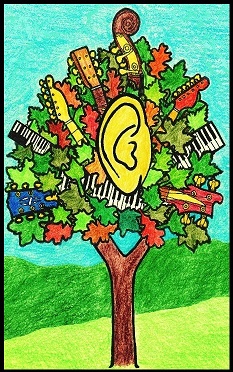 The role of memory is one of the most important, and one of the most neglected aspects of learning music. Memory is at the center of everything we do as musicians, but we hardly ever talk about it. Musicians rely on several different kinds of memory simultaneously. We form visual memories of written music, and where keys and frets are located. Our memory of note and chord names is a mix of visual and verbal memory. We have auditory memories of what a piece sounds like, and we have muscle memories of our hand movements. Along with all of this, we’re still dealing with our present reality in the moment, apart from memory.
The role of memory is one of the most important, and one of the most neglected aspects of learning music. Memory is at the center of everything we do as musicians, but we hardly ever talk about it. Musicians rely on several different kinds of memory simultaneously. We form visual memories of written music, and where keys and frets are located. Our memory of note and chord names is a mix of visual and verbal memory. We have auditory memories of what a piece sounds like, and we have muscle memories of our hand movements. Along with all of this, we’re still dealing with our present reality in the moment, apart from memory.
There’s a separate mix of long and short-term memory that tells you where you are in a piece at any given time. Am I playing the first chorus or the second chorus? Did I already take the repeat sign? Am I supposed to go to a verse or a bridge next? Learning music involves a complicated interaction between all of these simultaneous, disparate memories.
When you have memorized 90% of a song, then what you’re most likely to forget are transitions between parts. The transitions are usually the hardest things, and the last things, that you memorize. That’s when a chord chart on a music stand can be a life-saver.
Jocelyn Swigger gave a talk at a TEDx event at Gettysburg College in 2014 called, “How I memorize piano music.” She describes how she learns new pieces of music, and how she “translates” written music into actual music you can hear. First, she reads the new piece. As she practices reading and playing the piece, she develops a visual memory of the note names, and the note orders. As she practices more, these memories are transferred to her auditory memory and her muscle memory. Each type of memory reinforces the other. Perfecting a piece and preparing it for performance entails learning to rely more on your auditory and muscle memory, and less on your memory of the note names in order.
She discusses “information chunking,” how the mind naturally divides information into chunks, and how that applies to reading music and identifying notes. “Information chunking” is a real thing. There is a lot written about it, starting with a well-known research paper from the 1950s which said people can most easily memorize information in chucks of 6 to 8 items. That paper led to the US adopting seven-digit phone numbers.
Concert pianists almost always memorize their music. They don’t read music when they perform. If they’re playing with an orchestra, then the conductor is reading a score, and the orchestra are all reading their parts, but the pianist has all of his or her parts memorized.
Concert pianists aside, classical musicians read music almost the entire time they play. Rock musicians are much more likely to simply memorize everything they play, eliminating the need for any written notes. Because of differences in working practices, classical and modern musicians each rely on memory in different ways. These differences in working styles as it relates to memory are one of the main causes of the Classical/Modern Disconnect.
This goes to show that many of today’s classical musicians are more enlightened than the generations before them. They can more accurately explain the various physical and mental processes that go into making music than their antecedents.
© 2019, 2020 Greg Varhaug